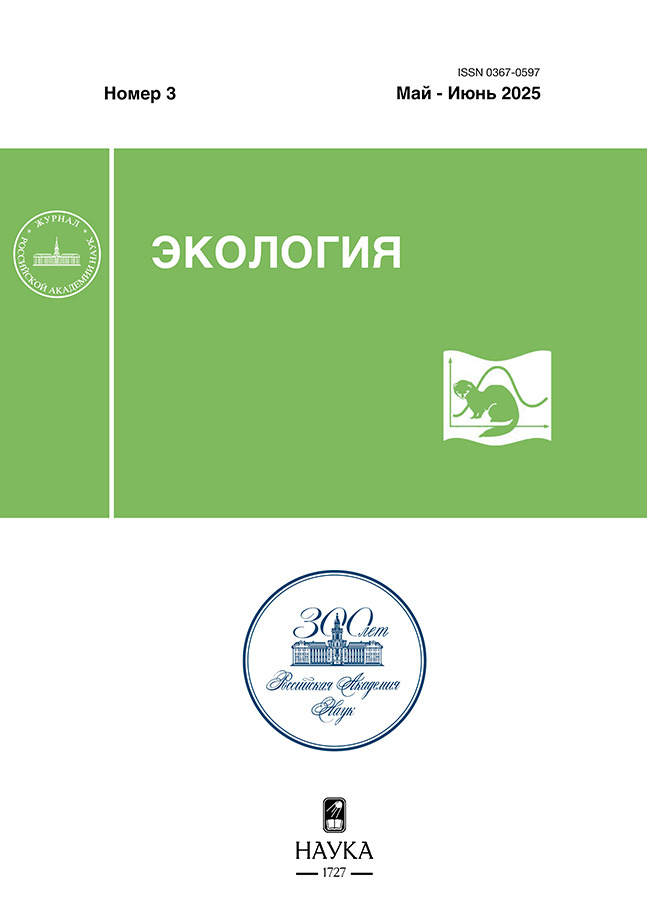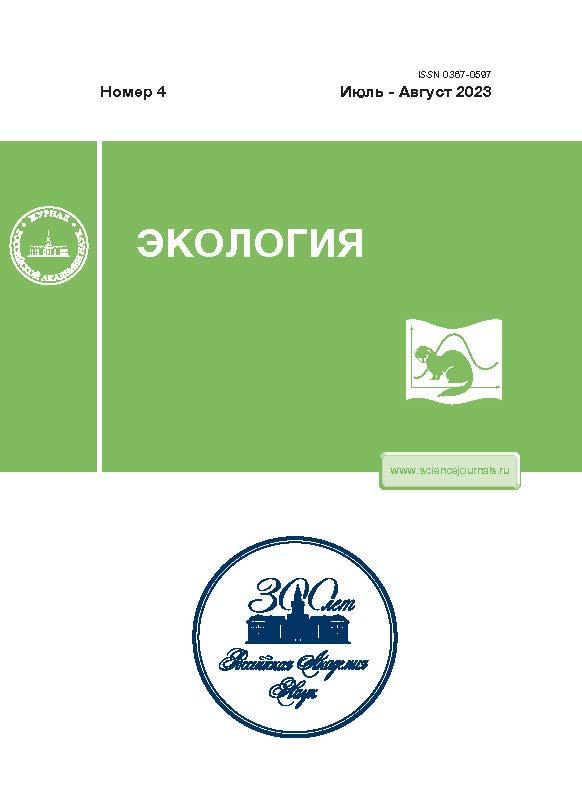Влияние инвазивного дождевого червя Eisenia nana (Lumbricidae) на содержание водорастворимых форм катионов (N\({\mathbf{H}}_{{\mathbf{4}}}^{{\mathbf{ + }}}\), K+, Na+, Mg2+, Ca2+) в почве
- Авторы: Бабий К.А.1, Князев С.Ю.1, Соломатин Д.В.1, Голованова Е.В.1
-
Учреждения:
- Омский государственный педагогический университет
- Выпуск: № 4 (2023)
- Страницы: 302-310
- Раздел: Статьи
- URL: https://rjonco.com/0367-0597/article/view/672026
- DOI: https://doi.org/10.31857/S0367059723040030
- EDN: https://elibrary.ru/RQARAP
- ID: 672026
Цитировать
Полный текст
Аннотация
С помощью полевого имитационного эксперимента в мезокосмах оценивали влияние почвенно-подстилочных дождевых червей – инвазивного E. nana и аборигенного E. nordenskioldi (в монопопуляциях и при совместном содержании) – на доступность катионов (N\({\text{H}}_{4}^{ + }\), K+, Na+, Mg2+, Ca2+) в почве. Установлены достоверное влияние обоих видов на рост содержания ионов натрия в слое почвы 10–15 см относительно контроля без червей, различия между моновариантами E. nana и E. nordenskioldi по содержанию ионов магния и кальция в слое 0–5 см и значимое влияние взаимодействия видов на рост доступности аммония в слое 20–30 см.
Ключевые слова
Об авторах
К. А. Бабий
Омский государственный педагогический университет
Email: labinvert@omgpu.ru
Россия, 644043, Омск, наб. Тухачевского, 14
С. Ю. Князев
Омский государственный педагогический университет
Email: labinvert@omgpu.ru
Россия, 644043, Омск, наб. Тухачевского, 14
Д. В. Соломатин
Омский государственный педагогический университет
Email: labinvert@omgpu.ru
Россия, 644043, Омск, наб. Тухачевского, 14
Е. В. Голованова
Омский государственный педагогический университет
Автор, ответственный за переписку.
Email: labinvert@omgpu.ru
Россия, 644043, Омск, наб. Тухачевского, 14
Список литературы
- Lavelle P., Decaens T., Aubert M. et al. Soil invertebrates and ecosystem services // European J. of Soil Biology. 2006. V. 42. P. 3–15. https://doi.org/10.1016/j.ejsobi.2006.10.002
- Blouin M., Hodson M.E., Delgado E.A. et al. A review of earthworm impact on soil function and ecosystem services // European J. of Soil Science. 2013. V. 64. P. 161–182. https://doi.org/10.1111/ejss.12025
- Bohlen P.J., Scheu S., Hale C.M. et al. Non-native invasive earthworms as agents of change in northern temperate forests // Frontiers in Ecology and the Environment. 2004. V. 2. P. 427–435. https://doi.org/10.2307/3868431
- Eisenhauer N. The action of an animal ecosystem engineer: identification of the main mechanisms of earthworm impacts on soil microarthropods // Pedobiologia. 2010. V. 53. P. 343–352. https://doi.org/10.1016/j.pedobi.2010.04.003
- Ferlian O., Eisenhauer N., Aguirrebengoa M. et al. Invasive earthworms erode soil biodiversity: a meta-analysis // Journal of Animal Ecology. 2018. V. 87. P. 162–172. https://doi.org/10.1111/1365-2656.12746
- Richardson J.B., Johnston M.R., Herrick B.M. Invasive earthworms Amynthas tokioensis and Amynthas agrestis alter macronutrients (Ca, Mg, K, P) in field and laboratory forest soils // Pedobiologia. 2022. V. 91–92. 150 804. https://doi.org/10.1016/j.pedobi.2022.150804
- Resner K., Yoo K., Sebestyen S.D. et al. Invasive earthworms deplete key soil inorganic nutrients (Ca, Mg, K, and P) in a northern hardwood forest // Ecosystems. 2015. V. 18. № 1. P. 89–102. https://doi.org/10.1007/s10021-014-9814-0
- Chang C.-H., Marie Bartz L.C., Brown G. et al. The second wave of earthworm invasions in North America: biology, environmental impacts, management and control of invasive jumping worms // Biological Invasions. 2021. V. 23. P. 3291–3322. https://doi.org/10.1007/s10530-021-02598-1
- Greiner H.G., Kashian D.R., Tiegs S.D. Impacts of invasive Asian (Amynthas hilgendorfi) and European (Lumbricus rubellus) earthworms in a North American temperate deciduous forest // Biological Invasions. 2012. V. 14. № 10. P. 2017–2027. https://doi.org/10.1007/s10530-012-0208-y
- Marichal R., Martinez A.F., Praxedes C. et al. Invasion of Pontoscolex corethrurus (Glossoscolecidae, Oligochaeta) in landscapes of the Amazonian deforestation arc // Applied Soil Ecology. 2010. V. 46. P. 443–449. https://doi.org/10.1016/j.apsoil.2010.09.001
- Huang C.Y., González G., Hendrix P. Resource utilization by native and invasive earthworms and their effects on soil carbon and nitrogen dynamics in Puerto Rican soils // Forests. 2016. V. 7. 277. https://doi.org/10.3390/f7110277
- Felten D., Emmerling C. Earthworm burrowing behaviour in 2D terraria with single- and multi-species assemblages // Biology and Fertility of Soils. 2009. V. 45. P. 789–797. https://doi.org/10.1007/s00374-009-0393-8
- Ferlian O., Thakur M.P., Gonzalez A. et al. Soil chemistry turned upside down: A meta-analysis of invasive earthworm effects on soil chemical properties // Ecology. 2020.V. 101. № 3. e02936. https://doi.org/10.1002/ecy.2936
- Голованова Е.В. Дождевые черви Омской области // Труды Томского гос. ун-та. Сер. биол. 2010. Т. 275. С. 111–113.
- Голованова Е.В., Князев С.Ю., Бабий К.А., Цвирко Е.И. Распространение чужеродного вида дождевых червей Aporrectodea caliginosa в естественных местообитаниях Омской области // Познание и деятельность: от прошлого к настоящему: Сб. науч. тр. конф. Омск: Изд-во Омск. гос. пед. ун-та, 2020. С. 299–302.
- Golovanova E.V., Kniazev S.Y., Babiy K.A. et al. Dispersal of earthworms from the Rudny Altai (Kazakhstan) into Western Siberia // Ecologica Montenegrina. 2021. V. 45. P. 48–61. https://doi.org/10.37828/em.2021.45.9
- Shekhovtsov S.V., Shipova A.A., Poluboyarova T.V. et al. Delimitation of the Eisenia nordenskioldi complex (Oligochaeta, Lumbricidae) using transcriptomic data // Frontiers in Genetics. 2020. V. 11. e01508. https://doi.org/10.3389/fgene.2020.598196
- Бабий K.A., Князев С.Ю., Голованова Е.В., Абраменко А.С. Влияние экзотического Eisenia nana (Opisthopora, Lumbricidae) на катионный состав трех типов почв юга Западной Сибири (эксперимент в микрокосмах) // Russ. J. of Ecosystem Ecology. 2021. V. 6. № 3. https://doi.org/10.21685/2500-0578-2021-3-4
- Kampichler C., Bruckner A., Kandeler E. Use of enclosed model ecosystems in soil ecology: a bias towards laboratory research // Soil Biology and Biochemistry. 2001. V. 33. № 3. P. 269–275. https://doi.org/10.1016/S0038-0717(00)00140-1
- Ros M.B.H., Hiemstra T., van Groenigen J.W. et al. Exploring the pathways of earthworm-induced phosphorus availability // Geoderma. 2017. V. 303. P. 99–109. https://doi.org/10.1016/j.geoderma.2017.05.012
- IUSS Working Group WRB. World reference base for soil resources. International soil classification system for naming soils and creating legends for soil maps. World Soil Resources Reports. Rome: FAO, 2006. 145 p.
- Булыгина О.Н., Разуваев В.Н., Александрова Т.М. Описание массива данных суточной температуры воздуха и количества осадков на метеорологических станциях России и бывшего СССР (tttr). Свидетельство о государственной регистрации базы данных № 2014620942. URL: http://meteo.ru/data/ 162-temperature-precipitation#описание-массива-данных (Дата обращения 16.12.2022).
- Перель Т.С. Распространение и закономерности распределения дождевых червей фауны СССР. М.: Наука, 1979. 272 с.
- Lê S., Josse J., Husson F. FactoMineR: An R package for multivariate analysis // J. of Statistical Software. 2008. V. 25. № 1. P. 1–18. https://doi.org/10.18637/jss.v025.i01
- Babiy K.A., Kniazev S.Yu., Golovanova E.V. et al. What determines ion content of Lumbricid casts: soil type, species, or ecological group? // Polish J. of Ecology. 2021. V. 69. № 2. P. 96–110. https://doi.org/10.3161/15052249PJE2021.69.2.003
- Frazao J., de Goede R.G.M., Capowiez Y., Pulleman M.M. Soil structure formation and organic matter distribution as affected by earthworm species interaction and crop residues placement // Geoderma. 2019. V. 338. P. 453–463. https://doi.org/10.1016/j.geoderma.2018.07.033
- Aira M., Pérez-Losada M., Crandall K. A., Domínguez J. Host taxonomy determines the composition, structure, and diversity of the earthworm cast microbiome under homogenous feeding conditions // FEMS Microbiology Ecology. 2022. V. 98. № 9. fiac093. https://doi.org/10.1093/femsec/fiac093
- Sapkota R., Santos S., Farias P. et al. Insights into the earthworm gut mult-kingdom microbial communities // Science of the Total Environment. 2020. V. 727. e138301. https://doi.org/10.1016/j.scitotenv.2020.138301
- Price-Christenson G.J., Johnston M.R., Herrick B.M., Yannarell A.C. Influence of invasive earthworms (Amynthas spp.) on Wisconsin forest soil microbial communities and soil chemistry // Soil Biology and Biochemistry. 2020. V. 149. 107955. https://doi.org/10.1016/j.soilbio.2020.107955
- Canti M.G., Piearce T.G. Morphology and dynamics of calcium carbonate granules produced by different earthworm species // Pedobiologia. 2003. V. 47. P. 511–521. https://doi.org/10.1078/0031-4056-00221
- Wu J., Zhang C., Xiao L. et al. Impacts of earthworm species on soil acidification, Al fractions, and base cation release in a subtropical soil from China // Environmental Science and Pollution Research. 2020. V. 27. № 27. P. 33446–33457. https://doi.org/10.1007/s11356-019-05055-8
- Uvarov A.V. Inter- and intraspecific interactions in lumbricid earthworms: Their role for earthworm performance and ecosystem functioning // Pedobiologia. 2009. V. 53. № 1. P. 1–27. https://doi.org/10.1016/j.pedobi.2009.05.001
- Kuzyakov Y., Blagodatskaya E. Microbial hotspots and hot moments in soil: Concept & review // Soil Biology Biochemistry. 2015. V. 83. P. 184–199. https://doi.org/10.1016/j.soilbio.2015.01.025
- Ahmed N., Al-Mutairi K.A. Earthworms effect on microbial population and soil fertility as well as their interaction with agriculture practices // Sustainability. 2022. V. 14. № 13. 7803. https://doi.org/10.3390/su14137803
- Kniazev S.Y., Kislyi A.A., Bogomolova I.N. et al. Territorial heterogeneity of the earthworm population (Opisthopora, Lumbricidae) of Omsk oblast and environmental factors: A quantitative assessment of the relationship // Contemporary Problems of Ecology. 2022. V. 15. P. 484–493. https://doi.org/10.1134/S1995425522050079
- Nguyen Tu T., Vidal A., Quénéa K. et al. Influence of earthworms on apolar lipid features in soils after 1 year of incubation // Biogeochemistry. 2020. V. 147. P. 243–258. https://doi.org/10.1007/s10533-020-00639-w
Дополнительные файлы















